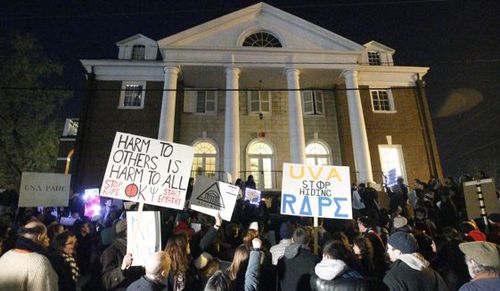![fratriot]()
Sabrina Rubin Erdely’s obsession with fictitious breaking glass inspired some real breaking glass. From the Washington Times last December:
Unpunished vandalism rampage inspired by Rolling Stone’s U.Va. rape story
Student activist who led vandalism attack on Phi Kappa Psi fraternity house says he has no regrets
By Jeffrey Scott Shapiro – The Washington Times – Sunday, December 21, 2014
In the wee morning hours after Rolling Stone’s now-retracted gang rape story roiled the University of Virginia campus, a masked group of five women and three men unleashed their fury on the Phi Kappa Psi fraternity house at the center of the controversy.
Bottles and bricks were tossed through nearly every first-floor window, sending shards of glass and crashing sounds into the house around 2:30 a.m. on Nov. 20.
Profane, hate messages such as “F—k Boys” were spray-painted on the walls of the colonial facade, along with anti-sexual assault epithets such as “suspend us,” and “UVA Center for Rape Studies.”
The Charlottesville, Virginia, police blotter unmistakably describes the attack as a crime. “Vandalism and destruction of property,” it reads.
Felony charges also could be attached because the crime involved throwing dangerous objects into a private dwelling and because the damage may total over $1,000. It’s unclear how many fraternity brothers were in the house at the time.
Yet more than a month after the attack, no arrests have been made and no charges have been filed. The fraternity house, its shattered windows now boarded with plywood, remains vacant. Like the Ferguson riots, there has been little accountability for those who perpetrated violence in the name of protest.
Police and prosecutors declined to say whether or when they might make arrests in the attack on the fraternity house.
Yet finding a student willing to admit his or her role as well as eyewitnesses who saw the group conduct the attack was relatively easy for a Washington Times reporter who spent two days on campus. After all, a witness who found a cellphone at the scene he believed belonged to a perpetrator gave the device to police.
The witness, who spoke to The Times only on the condition of anonymity because of fears of retaliation, said the cellphone had a text message from a second person he believed also participated in the attack. “That was exhilarating,” the message said.
After finding witnesses, cellphone information and social media postings bragging about the attack, The Times tracked down a male student identified by witnesses as a possible leader of the attack. The student agreed to talk to The Times only on the condition that his name wasn’t published, saying he didn’t want police to find him.
Is America like Nazi Germany, where mobs can smash windows of the disprivileged with impunity?
Will any arrests ever be made in this crime?













